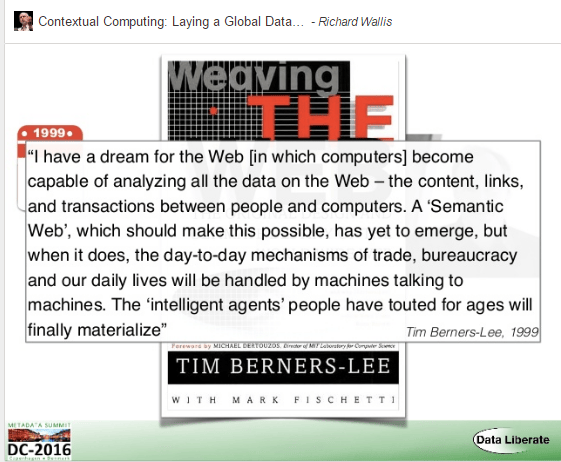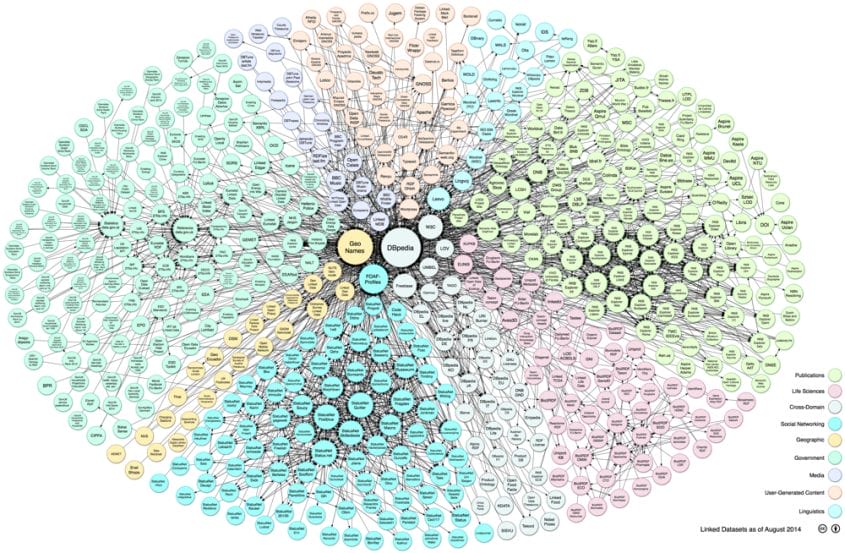Over the last five years, the “Internet of things ( IoT) has emerged to define how physical devices (vehicles, buildings, fridges, sunglasses, etc), embedded with technology, can collect and exchange data. This future state allows everything to be connected. How do we find the information or thing we are looking for in this connected future?
For example, if it is a building that is connected, how do we know its address? Or which companies reside inside? Where can we find those companies online? What products and services do they offer?
I believe that Schema markup can be the language to bring context to all things. It can define the relationships on the web so that we can navigate the world’s knowledge graph to find the answers we are looking for.
What Will Bring Context to All These Connected Things?
Let’s look at how this same problem exists on the web.
Today, millions of websites are connected on the internet. These websites have hundreds of pages with content about the business, ideas, topics, people, products, services, etc. In an effort to provide answers to their searchers, search engines have to figure out the context of the pages, so it can answer the searcher’s query accurately.
In order to solve this problem, Google, Bing, Yahoo and Yandex created the language of search engines, called Schema.org. Schema Markup is to be used by businesses to explain their web pages in a language the search engines can understand. This new standard vocabulary creates an open source way to understand the meaning of webpages. Could it also be used to define the meaning of other things?
Richard Wallis, a thought leader in the semantic web, in his presentation titled ““the future is global and contextual”. He shares Tim Berners-Lee’s vision for the internet from back in 1999. Mr. Berners-Lee mentions “all the data on the web” – could this be data from Schema markup that can be read and understood by machines? If it is, then his vision for the Semantic Web is here today.
Could Schema.org be Used to Define the Meaning of Connected Devices in the IoT?
Most people think about using Schema markup to explain the content on the page. In addition to explicitly defining the content, it can also define the content’s relationship in the bigger world, or Knowledge Graph. What do I mean? Here are some examples of relationships you can define with Schema markup.
- You are a franchise owner. You can use the markup to explain that you are a subsidiary of a larger brand, the city that you are located (Wikipedia entry), and the type of service you provide (Wikidata entry).
- You offer your services in French (Wikidata entry), and are a member of the Paris (geonames.org) Chamber of Commerce (website), use Schema markup to explain these relationships.
- A news article that is the authority on not one news item, but how a group of news items (link to all related news) happening across a country (Wikidata entry) are related and could result in an investigation (police report document reference).
- A product (GTIN) created by a company (website) that solves a specific medical ailment (Medical Code)
- A person knows someone else, indicating an existing working or personal relationship.
By connecting, or rather relating, to other things or entities in the world, you are truly defining the context of your business and connecting your business in the knowledge graph. Why is this important? In the world of IoT, everything will need to understand who you are, what you offer, and how you can help them.
Linking Data Is Not New
Linking data is not new. The idea of connecting information to clarify it has been around as long time. In fact, it is the basis of the semantic web.
For example, http://linkeddata.org/ was created to use the web to connect related data that wasn’t previously linked, and there is a lot of data out there. The image below shows the data sets that have been published in Linked Data format, by contributors to the Linking Open Data community project and other individuals and organizations.
While this information is linked, is it actually useful in answering questions?
This is another example of where Schema markup can help bring context to all the linked data by being clear about the relationship between each data item.
How Will You Navigate All the Data
Millions of data points and “strings” exist on the web, in open data, and on connected devices, how will you navigate them to find what you are looking for?
This is a question that Google has based their business on and their answer is their Knowledge Graph. Back in 2012, Google announced their knowledge graph with the goal of understanding “real world entities and their relationship one another” so that they could better answer the search query with the relevant answer.
In the blog, they call their knowledge graph as “a critical first step towards building the next generation of search, which taps into the collective intelligence of the web and understands the world a bit more like people do.” As the internet of things grows, identifying the real world entities and their relationships to other things will be paramount in order to be found.
Today, Google recommends you explain what something “is” using schema markup, or in their words, structured data.
What is a Knowledge Graph?
According to wikipedia, “the Knowledge Graph is a knowledge base used by Google to enhance its search engine’s search results with semantic-search information gathered from a wide variety of sources. Knowledge Graph display was added to Google’s search engine in 2012, starting in the United States, having been announced on May 16, 2012.”
The sources for the knowledge graph include schema markup, Wikidata, Freebase, Open Data, and more. It is Google’s map to the content on the web. Could this same approach be taken for all things connected? Could Schema Markup be the language to bring context and define relationships?
The Context of Things
So in the future where everything is connected, the web will encompass more than web pages.
It will include watches, fridges, clothing, devices and maybe even people. How will the watches, fridges, clothing, devices and people know if something they are interacting with is relevant to them.
Schema markup, the foundation of the semantic web, brings this context. It is being used today with success to define all the aspects of a business so that Google can find the business entity the searcher is looking for. It will also require a layer that brings context and defines relationships. A layer we could call the “Context of Things”. This context layer is what will drive not only the semantic web, but the semantic web of all things connected. Today, the context layer on the web is Schema markup.
Could it be used to bring the context of all things?
We love to use schema markup to help search engines contextualize data. This way, Google can better match your content to a user’s search query, resulting in better engagement and conversion rates through search results. Set up a call with our technical experts today to see what structured data can do for you!
Start reaching your online business goals with structured data.

Martha van Berkel is the co-founder and CEO of Schema App, an end-to-end Semantic Schema Markup solution provider based in Ontario, Canada. She focuses on helping SEO teams globally understand the value of Schema Markup and how they can leverage Schema Markup to grow search performance and develop a reusable content knowledge graph that drives innovation. Before starting Schema App, Martha was a Senior Manager responsible for online support tools at Cisco. She is a Mom of two energetic kids, loves to row, and drinks bulletproof coffee.


